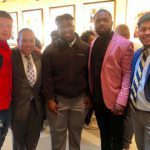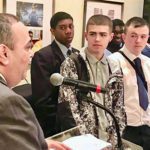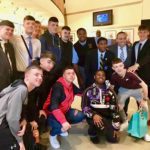African-American youth from a Newark public high school thought a cultural enrichment trip to Northern Ireland was going to be a bad experience in December.
They assumed white kids, ages 15 to 19, from Belfast would not understand racial issues they face in America.
“We’re not going to be able to relate to these guys," said Zachery Halley, a 19-year-old at Eagle Academy for Young Men. “They’re not going to understand our struggle."
But then they saw a mural of African-American civil rights leaders. There was Frederick Douglass, Rev. Martin Luther King Jr., Harriet Tubman and so on. Their images were on a peace wall that has divided Catholic and Protestant communities in Belfast based on religion for the last 50 years.
To the surprise of Newark students, this group of Belfast youth identify with these historical figures, looking to them as examples of how to challenge oppression and the religious discrimination they face.
They look toward Newark, too, and are encouraged by how the city emerged from the 1967 riots, a civil disturbance fueled by racial discrimination, poor housing conditions and unemployment.
Discussion of that reality continued Wednesday, this time in Newark with 15 Belfast teens visiting for a week with the 10 Eagle Academy students who met them in December.
“We wanted to go over here to Newark to see the possibilities," said Brandon Donaghy, 19, who is a Catholic from Belfast. “We want the young people (in Belfast) to see that Protestants and Catholics can come together. Our differences are just religion and nothing else."
They are part of a Global Ambassadors program created three years ago to unite Protestant and Catholic young people who live in Belfast’s poorest communities - Lower Shankill and Divis. Both are separated by a wall that is eight miles long and 18 feet high. It was erected during a conflict that started in 1968 from a campaign to end religious discrimination against the Catholic/nationalist minority by the Protestant/unionist government and police force.
Stephen Hughes, a senior youth development officer of the ambassador program, said Catholics had their own rebellion, much like Newark and urban cities across America.
“Yours was race-related riots; ours was sectarian," he said
Catholics couldn’t vote or own property, but they studied how King fought for civil rights and how Newark rose from its tumultuous period in history. “While you had your rebellion, we were watching back home," Hughes said. “That’s why we’re in Newark, because Newark led the way. We want to learn from Newark."
That idea resonated with the New Jersey kids.
“They’re actually looking at us for solutions to their problems, while we’re still figuring out how we’re going to fix our problems,” said Joshua McLean, 17, of Eagle Academy.
The Eagle Academy kids learned about the sectarian discrimination before traveling to Belfast, but it didn’t register until they were there.
“Why is everybody so separate?" asked Ajani Carter, 17, recalling the segregation and the wall. “They were dealing with discrimination, but it was off of religion."
Mark Hawthorne, an 18-year-old Protestant from Belfast, said he was nervous at first about participating in the ambassador program that would bring him together with Catholics.
“But I built a friendship and we made a video of it," Hawthorne said.
Through dialogue, the Newark and Belfast teens have more in common with each other regardless of race and religion.
Both come from neighborhoods struggling with education, crime, gang violence, and conflicts with police. Socially, the musical taste is the same. They listen to rap artists like J. Cole and Drake, and the late Nispey Hussle, Tupac and Notorious B.I.G.
The international union between Newark and Belfast has been eight years in the making. Hughes said he visited Newark in 2011 with youth workers – we call them social workers – to look at education in Newark.
He met Thomas Owens, who is the director of corporate and community partnerships for Eagle Academy. Both men struck up a friendship that continued a year later when Eagle Academy opened. They had a lot in common, too, and that is empowering young people with life experiences.
“This has been closest to my heart," Owens said.
“Eagle Academy is changing the educational attainment for young men of color—that to me was something I had an affinity,” Hughes said.
Eagle applied for a grant to make the trip happen last December. The Belfast kids are here now until Sunday. On Wednesday, they talked about violence and solutions at the Help Us Become Better Community Empowerment Center, better known as the HUBB, in Newark.
Back home in Belfast, Hughes said the wall is still there even though there is very little conflict since the 1998 peace treaty to end the war.
“We can’t take the wall away physically, but we can take the wall away in people’s heads through relationship and friendship."
In that circle, they can count on Newark, too.


